This story was originally published in Heavy Table’s Substack newsletter for September, 13, 2024 and was made possible by its paying subscribers.
Three of the four corners at Lake & Hennepin—the center of Minneapolis's much-discussed Uptown neighborhood—are vacant retail storefronts. The fourth is a mostly empty urban mini-mall that has been slowly bleeding retail tenants since before it was purchased in 2019 by Chicago-based real estate investment firm Northpond Partners.1
In 2020, after renaming the mall Seven Points, Northpond announced plans to convert the vacant piece of land along Lake Street to the east into a 14-story tower with over 400 apartments. In February of 2022, the same firm announced additional plans to turn properties along Hennepin Avenue into more than 200 apartments and over roughly 70,000 square feet of retail space.
As of September 2024, neither project has started.
Northpond bought the property for a steep discount in 2019, paying less than half of what the prior owner did in 2014. Retail was already starting its backslide before the pandemic, with stores like Heartbreaker and Victoria’s Secret closing in 2017 and 2018 respectively. Since then Fjällräven, MAC Cosmetics, Timberland, The North Face, Apple, Urban Outfitters, Juut Salon, People’s Organic Restaurant, H&M, Columbia Sportswear, Arc'teryx, AT&T, Paper Source, American Apparel, Jonathan Adler, ROAM Furniture, John Fluevog Shoes, Stella’s Fish Café, and more have all closed in Uptown. In 2021 Kitchen Window, a 35-year neighborhood staple, also closed.
“Kitchen Window was a nexus for people who were serious about food,” says Heavy Table’s editor, James Norton. “Nowhere else in the U.S. could you find more stuff on the shelves and get your eyes on whatever gadget you wanted, while talking to truly knowledgeable staff. There was nothing else quite like it.”
Jeff Herman, an Uptown commercial property owner with Urban Anthology who has been involved with several major retail projects in the area, says what’s happening is, “a perfect storm of remote work, retail atrophy, and other demographic shifts that are having an impact all over the country, that have also caused the temporary demise of Uptown.”
How Did Uptown Even Become Uptown?
Minneapolis was a busy summer tourist destination in the late 1800s and early 1900s up until air conditioning and air travel became more common in the middle of the 20th century. You could take the train to Minneapolis or St. Paul and then ride streetcars all the way to summer resorts on Lake Minnetonka, passing through the Minneapolis Chain of Lakes along the way. The old Lyndale Hotel stood on the hill above the east side of Bde Maka Ska where St. Mary’s Greek Orthodox Church is today, and “Hennepin-Lake” (as it was then called) was full of restaurants and shops for tourists and locals alike.
The Chain of Lakes was dredged in the early 1900s to deepen the lakes so they looked bluer, with the dredgings being used to convert swampland into parkways and walking paths.
The first of the many reported deaths of Uptown took place in the transitional period after tourism and before the area’s rebirth as a local retail hub, with grocery stores, restaurants like Rainbow Cafe, and the Uptown Theater all coming into the area in the early to mid-20th century. The large theaters of generations past gave space for an ’80s punk scene that brought people from outside the neighborhood back into Uptown.
The “Uptown McPunks” of that era would eat cheeseburgers on the McDonald’s patio at Hennepin & Lagoon and scare passersby. “All they want, they say, is a place to catch up on gossip… to burn cigarettes, to see and be seen,” read a 1984 Star Tribune piece on people being afraid of Uptown before it was even really known as Uptown. The Uptown McPunks were fortunate to exist in an age prior to social media, because if it happened today that Crime Watch social media account would be scaring people in greater Minnesota shitless with photos of them on Hennepin blasting cigs and sharing hot goss in their black leather jackets.
Eventually more people wanted to go where the cool kids were hanging out, and Uptown became widely known as a hip spot. As is often the case, large corporate chains took notice of the area’s popularity and started filling the spaces with large-format stores in the 1990s and early 2000s.
When the Uptown Theater was rebuilt in 1939 its owners added the landmark “Uptown” sign above the building, but the area was still mainly referred to as “Hennepin-Lake” until the 1980s. When the old Calhoun School was sold by the school board and developed by Ray Harris into what is now Seven Points, he claims to have invented Uptown (even though Prince released “Uptown” four years before Calhoun Square opened).
Harris was the first head of the Hennepin-Lake Association, which later became the Uptown Association. Though it’s often confused with a neighborhood association of some sort, the Uptown Association is a private group consisting mainly of commercial property and business owners collectively working to maximize the return on their investments in Uptown.
The group hosts the Uptown Art Fair primarily to bring people to Uptown and showcase their investments, but last year that fair was moved to the Bachman’s parking lot four miles south of Uptown. Just as suburbanites often believe that Uptown can be anything south of I-94 between the lakes and I-35W, the Uptown Association seems to still believe that “Uptown” is an abstract description of any area where the term could be beneficial from a marketing perspective.2
The Suburbanite Fun Zone
After people stopped being scared of the McPunks and corporate retail started moving in, the inertia brought Uptown to a frenzy in the late ’90s and into the 21st century. Before the era of smartphones and online reservations, you had to just show up to Famous Dave’s and wait. Back then, it was normal to have an hour-long wait, and the shops nearby were a great way to pass that time. A symbiotic relationship between retail and restaurants snowballed to a point where eateries like Figlio and Chino Latino could fill 10,000-square-foot spaces every night, with people still spilling out onto the sidewalks with live blues from Famous Dave’s as background music.
If Chino Latino opened today with what it called “global street food,” it would probably be viewed as a bland appropriation of a disjointed alignment of cultures that’s been dulled down for Minnesota palates, but in 2004 it was quite avant-garde. “You felt like you were discovering something new when you went there,” Norton says. That’s a lot of what Uptown was at the time: something you couldn’t experience anywhere else. Local real estate agent Ben Krsnak pegged the “heyday of Uptown” as “probably the late ’90s to 2006 or 2007” in a 2023 Business Journal piece about the space that’s been empty for years now.
As demand increased and outside investors gobbled up rapidly appreciating commercial properties in Uptown, rent spikes followed. Eventually everyone except companies like H&M and Victoria’s Secret were priced out of the neighborhood.
Then the bubble popped.
Nobody can identify a peak until you’ve gone past it, and commercial leases tend to be around five to 10 years in length, so the sunsetting of Uptown appears to have started in earnest roughly a decade after the 2008 Great Recession, in that 2017-18 range when Heartbreaker, Victoria’s Secret, and others started closing. That retail collapse was accelerated by the pandemic, and shopping in Uptown has followed the retail “death spiral” that suburban malls have also experienced in the past few years. Gone with that retail traffic is the spillover consumer spending in neighboring restaurants and stores.
“When I moved here in 2017 I didn’t have a lot of friends, so I’d ride my bike around the Chain of Lakes and bop around Uptown,” says Em Cassel, former editor in chief of City Pages and co-founder of Racket. “I can still ride my bike around the Chain of Lakes, but the bopping options aren’t there. When I get my hair cut in Uptown, I still get a book at Magers & Quinn, but that’s all I still do because that’s all that’s still open.”
That reduced bopping is impacting local businesses in Uptown.
“When I first opened people would come in with their little Victoria’s Secret bag, with their little Apple bag, and that’s not happening anymore,” says Jennifer Lisburg, the owner of Sugar & Salt at 32nd & Hennepin. Her cafe is one of the few places besides Jimmy John’s where you can still get a sandwich on a Tuesday in Uptown.
No-Show Jobs
Even though there isn’t a ton of office space in Uptown there are still several multistory office buildings, including two recently added Mozaic office towers on Lagoon that are both mostly empty. My office has been in Uptown since 2018, and I’ve seen the slow decline firsthand over the past six years.
Just like the impact remote work had on central business districts, remote work has diminished the already small daily office traffic in Uptown to almost zero. Even if workers are still coming into an office, it’s usually on a hybrid schedule of a few days per week, which further dilutes lunch and happy hour crowds.
The pandemic era national uptick in crime also impacted both the perception of Uptown as well as the cost of doing business. Lisburg had her truck stolen (twice), as well as a trailer and generator she used for events, but she also says it feels like crime is coming down this year (and the data shows that as well).
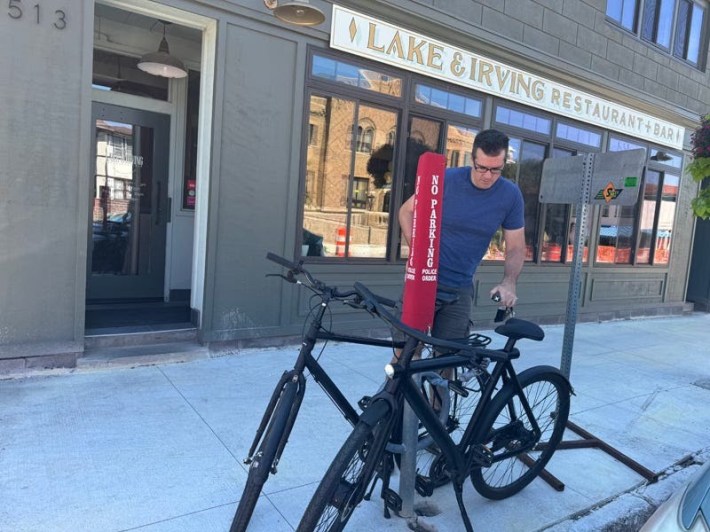
“So much of the problem is the livability stuff that MPD can only react to afterwards, stolen bikes, smashed car windows,” says John Edwards, founder of the hyper-local Minneapolis news source Wedge Live that hosts the nationally renowned Wedge Live Cat Tour in the Wedge Neighborhood which borders Uptown.
Edwards believes the lack of people in Uptown is part of the issue and is supportive of a proposed ambassador program for Uptown that’s being pitched in the Minneapolis City Council right now by Council Vice President Aisha Chughtai and Council Member Katie Cashman (whose wards intersect in Uptown). “Having people around, stereotypical eyes on the street, somebody in a uniform, somebody official looking is standing around, you’re probably less likely to break a window or steal a bike," he says.
Council Member Cashman supports a multipronged approach to addressing the issues in Uptown.
“The first conversation Aisha and I had was ‘what are we going to do about Uptown,’” Cashman says. “We made a $9-million investment in police, but police alone aren’t going to save Uptown. That’s why we need viable complements to police, one being Behavioral Crisis Response and the other being ambassadors, and that’s been working downtown. Police leaders in downtown and Uptown will be the first to tell you how helpful BCR and ambassadors are to support their work.”
The Negative Externalities of Someone Else's Vacant Space
Just as retailers used to benefit from suburban diners wandering into their stores from overflowing restaurants nearby, now they have to hope their customers are willing to walk past a handful of vacant storefronts to get to them. Most of the east side of Hennepin between Lake & 31st is empty and waiting to be torn down by Chicago-based Northpond Partners’ long-awaited development.
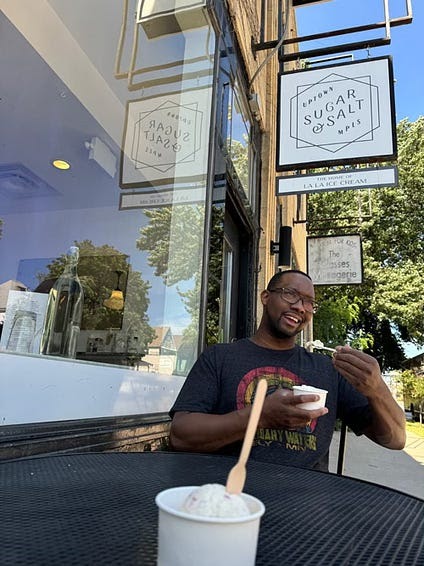
“What frustrates me about rent seekers is they can wait to benefit off of enterprising individuals to increase values in the neighborhood,” says Lonnie McQuirter, owner of 36 Lyn Refuel Station a few blocks from Uptown and a board member of the Minnesota Retailers Association and the National Retail Federation. “The investment group that bought Seven Points were focused on a low-interest rate environment because they were looking to make a gain and they lost. There’s a ton of investors that engage solely in rent seeking behavior and their attitude is ‘rents will go up and if it sits vacant it sits vacant’ but they don’t add anything.”
Perpetually vacant buildings are a problem all over Minneapolis, particularly on the city’s North Side where the 2008 mortgage crisis disproportionately hurt communities of color. The Minneapolis City Council has even amended an ordinance to increase fines on buildings that absentee landlords are leaving empty for multiple years and allowing to deteriorate.
Vacant buildings hurt communities; when they start to aggregate, owners can become even more reluctant to invest money in improvements that might attract new tenants. The idea is that the increased fine will nudge the landlord into doing something, whether that be improving the property or selling it to someone else who will.
Tasting Room sommelier and co-owner Nico Giraud (formerly of Spoon & Stable, Bellecour, and Meritage) calls losing his next door neighbor Kim’s last month “a bit of a fucking disaster” because of the loss of the complementary traffic and what it will mean for people coming to the neighborhood. “When I was at Spoon and Stable it was important to me that Bachelor Farmer was busy because that means the neighborhood is busy," he says.

However, Giraud isn’t longing for the days of corporate retail. “If you want Gap, Victoria’s Secret, Apple, go to Mall of America,” he says with a sophisticated disdain that can only really be accomplished with a French accent.
Kim’s closed August 26, two months after workers voted to unionize in what became a highly contentious fight with the James Beard Award-winning owner Ann Kim. Unite Here Local 17 filed labor charges against Kim’s and their parent company, Vestalia Hospitality, shortly after the restaurant abruptly closed with only a few days’ notice, and at the time of this writing legal proceedings are still pending. Workers at Kim’s were given so little notice of the closure that they started a GoFundMe to cover employee transition costs.
Kim bought the building where her restaurant was located. Its main tenant, Paper Source, closed in February. This left Kim’s to subsidize the vacant retail space with an already challenged restaurant. At that time Ann Kim said: “…Uptown is faced with many challenges so it will require committed and creative business owners and leaders to bring this neighborhood back. I'm tired of hearing people complain and whine about the state of Uptown. If you don't like it, do something about it.” (We reached out to Kim for comment via Vestalia Hospitality; she didn’t respond.)
(Lots of) Space for Rent
The empty space in the Kim’s building only represents a small fraction of the Uptown vacancies.
“No one wants vacant spaces, not landlords, not nearby businesses, not people in the neighborhood," says commercial landlord Jeff Herman. "And most landlords in Uptown would gladly lease out their properties on very favorable terms to any good business right now."
The problem is even with favorable terms you still have to build out a space and pay for inventory and employees, regardless of rent. The annual cost to simply operate inside a space like the old Chino Latino would easily be in the six-figure range, before you paid a dollar of rent. Carving up a large space into smaller spaces would also cost landlords hundreds of thousands, or even millions, at a time when properties are already distressed.
The end result is the slow decay of multimillion dollar buildings—which used to be filled with people—now owned by investors like Northpond that have no ties to the neighborhood.
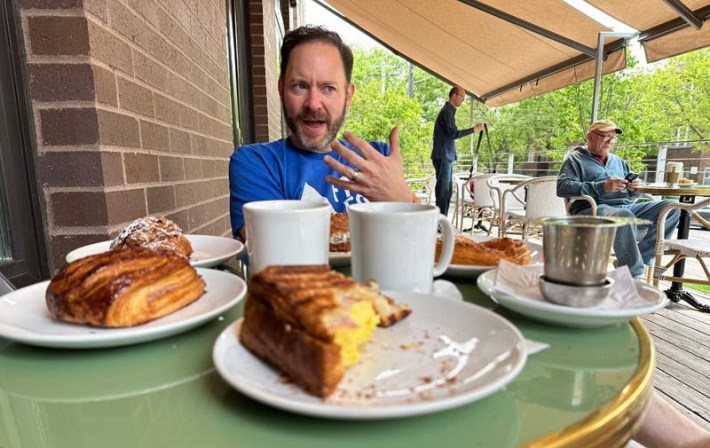
“Uptown has often been misunderstood by investors who live and die by data. The average income in that area is crazy,” says local TV and radio personality Jason DeRusha. “Cities change and our population may only really be able to support two destination nodes. Right now, the Uptown energy moved to North Loop, with 50th & France being that other node.”
While Uptown may never turn back into the destination retail node that it once was, there’s still a lot to like about the area. The Chain of Lakes that were beautified for tourists a century ago aren’t going anywhere. There are also a lot of people in Uptown, which is now one of the most densely populated areas in the state of Minnesota.
“Uptown has advantages downtown doesn’t have because we have the people here already,” says Wedge Live’s Edwards. “But we can’t win on car-centric commerce, and we can’t beat Eden Prairie on parking spots.”
The Restaurants of Uptown
If this cluster of restaurants were in any other part of the Twin Cities, that neighborhood would never shut up about them
Nobody really longs for the days of corporate retail, and there’s a hope that the next phase of Uptown will be one focused on the neighborhood instead of trying to entice suburbanites to come here and shop. For now, though, there are still a lot of really great places to eat in Uptown.
LAKE & IRVING RESTAURANT & BAR
John Edwards of Wedge Live and I met for lunch at Lake & Irving, named for the intersection where it sits in Uptown, to talk about Uptown. We both biked there and shared a bike rack on Lake Street in front of the restaurant. He moved to the area “because of its walkability” and is excited about what’s being built in terms of pedestrian and biking infrastructure in Uptown right now, but that construction is still in progress and the street and sidewalk outside the restaurant were still torn up the afternoon we met.
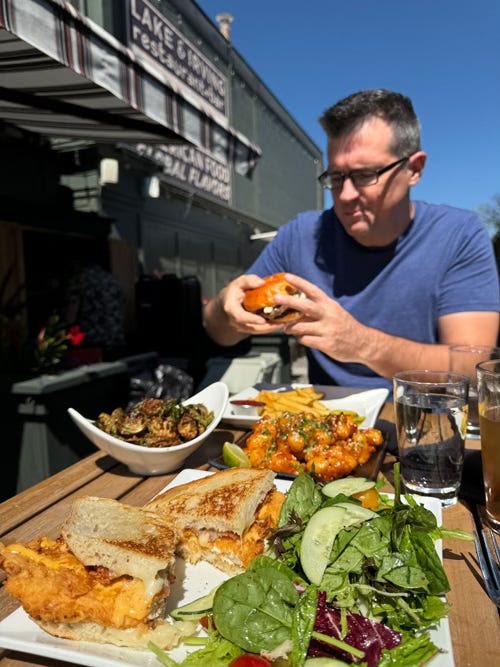
Our server described the construction as “shitty,” but said that patronage at the restaurant had been steady and things seem to be “moving in the right direction” in Uptown. John ordered the cheeseburger ($20), which is made with Sakura Farms wagyu and comes with shallot aioli on a brioche bun.
We also shared the KFC ($13)—Korean style fried cauliflower with gochujang, honey, lime, and sesame—and the fried Brussels sprouts ($13) which come with white soy, patis, and togarashi.
I had their signature buttermilk chicken sandwich ($20), a thinly sliced breaded chicken breast on toasted La Brea sourdough with Duroc bacon, Cady Creek Farms pepper jack, with sriracha aioli. You can also get it with ghost pepper jack or ghost pepper aioli for an extra $1.50.
Between bites Edwards talked about how great Uptown is and how it will be even better once the Hennepin Avenue construction is finished.
“We’re doing so much better on streets," he says. "This is going to be an even more walkable neighborhood than the one I moved here for because of the bike lanes and wider sidewalks that are coming.”
ISLES BUN & COFFEE
When I met Council Member Katie Cashman at Isles Bun and Coffee on Hennepin & 28th, the line was around the corner. We queued in the late August sun for around 15 minutes with neighbors all waiting for their freshly made pastries.
“This is where I grew up, serving in the Uptown Diner and spending my paycheck at Urban Outfitters and with my friends at Cheapo Records,” Cashman says while we wait outside the restaurant. “Uptown is such a nostalgic place for so many people, and that’s what can bring it back. Everyone has great memories here.”
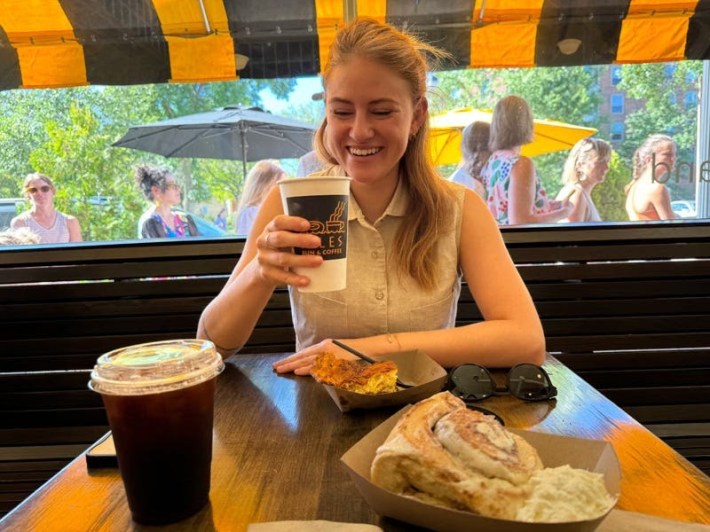
Cashman ordered the quiche ($6) which she says has been the same recipe as long as she’s been coming to Isles Bun, which opened in 1993. I got a cinnamon bun (also $6), which was simple in terms of ingredients but still piping hot to the point that I needed a napkin underneath the cardboard tray to insulate my hand while I carried it to the table. The bun also includes a thick slab of homemade icing, which is placed to the side in the tray because it would melt if it were slathered on top.
Over coffee the first-term council member talked about her fond memories of Uptown and what she sees as a need for urgent discussion regarding its future. “There’s conversations around real estate that are happening downtown that aren’t happening in Uptown, and I think we need to get the stakeholders at the table," she says, adding: “we can’t afford to do nothing.”
SUGAR & SALT—THE HOME OF LA LA ICE CREAM
Formerly La La Ice Cream, Sugar & Salt is the expansion of the luncheonette menu Jennifer Lisburg had been slowly adding over time at La La. She describes the food as “homey, for modern tastes” and has scratch made soups and a variety of sandwiches. I recommend the Havarti pesto chicken sandwich with bacon ($15.50) which comes with organic chicken, house made walnut pesto, and Havarti.
On a late summer day I met Lonnie McQuirter at Sugar & Salt for a couple scoops of La La Ice Cream. As we sat on the sidewalk patio along Hennepin, Lonnie expressed his frustrations with unimaginative landlords that have gobbled up much of the properties in Uptown. Lonnie talked about a building he tried to buy nearby that got swept up by an investor with access to more funds from outside the state. It wasn’t all bad, though. We both had a great scoop of ice cream ($6).
TENKA RAMEN
While it may not be the most complex ramen in the city, Tenka is legit and a great weeknight ramen spot. Most of the customers that came and went when I joined Heavy Table’s James Norton there on a Wednesday night were grabbing takeout orders, many appear to have walked to the restaurant.
Located next door to the now vacant Stella’s Fish Café, we were just a short walk to Bde Maka Ska. “The geography of Uptown is a golden opportunity for anyone with creativity and guts, but right now economics is standing in the way,” James said over a bowl of ramen. James ordered the torishio ramen ($13), karaage chicken in chicken broth with a boiled egg and corn. [2]
I got the tonkotsu ($14), pork belly in pork broth with roasted seaweed, bamboo, wood ear mushrooms, boiled egg, and scallions.

Over green tea we talked about some of the interesting places that have come and gone in Uptown. Places like Figlio and Chino Latino remain memorable; the Uptown punk mentality was a safe space to let loose with your menu in a way that the businesslike stuffiness of downtown Minneapolis historically hasn’t. On that night, however, the only other business open on that section of Lake Street was a vape and tobacco shop and Tenka closed shortly after we finished our meal.
TII CUP L2
The second level of Tii Cup on Hennepin & 27th is a speakeasy with a patio that overlooks the north end of Uptown. I met Racket co-founder and former editor in chief of City Pages Em Cassel there for happy hour—just in time to see the end of the road construction work on Hennepin that evening.
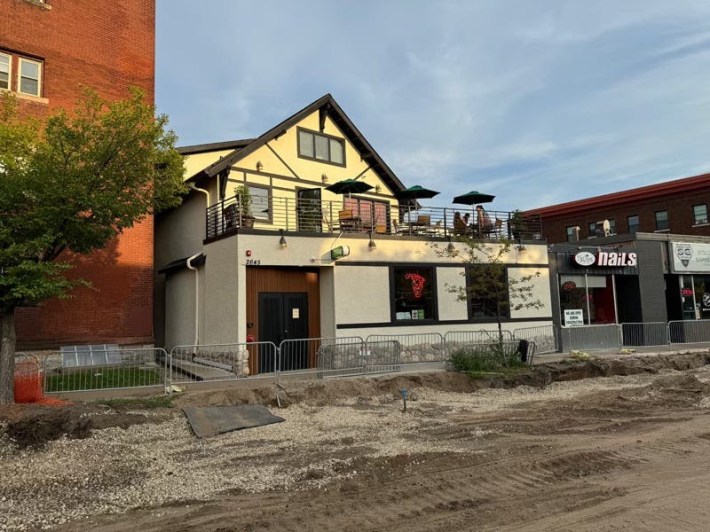
The speakeasy has a “street food” menu and we shared the popcorn chicken ($7.55), tofu squares ($6.25), and taro fries with ube dip ($5.45). The food was really good for simple happy hour fare, with more flavor than you’d expect from a fryer, but the real star at Tii Cup L2 is the cocktails.
Over a boba filled tom-yum ($11) and a Vietnamese Coffee inspired espresso martini ($12) Em shared her fond memories of Uptown from when she first moved to Minneapolis in 2017. “At that time, we were talking about how Uptown is dead,” when compared to its peak of a decade earlier, she says.
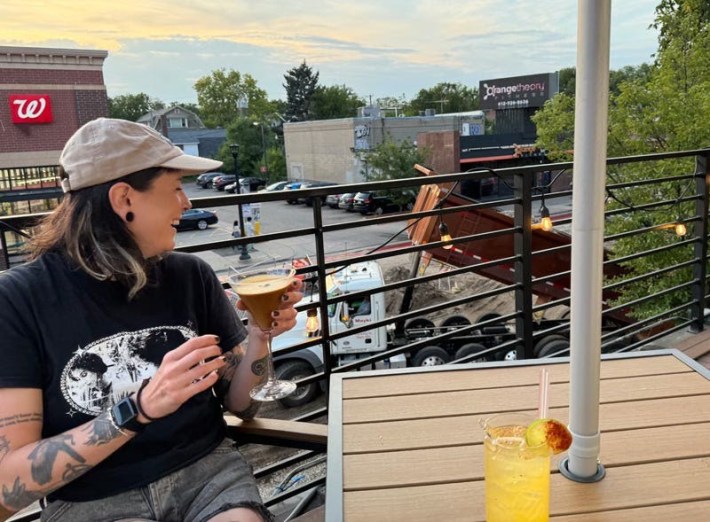
The view from the patio above Tii Cup looks towards Lake of the Isles at a slight angle due to the bend in Hennepin Avenue there to follow the shape of the lake. When it’s completed it will be a great spot, but on this night road construction noise polluted the vibe. At one point a dump truck emptied out a full load of gravel right behind Em, but otherwise it’s a lovely space.
PIMENTO AT THE LAKE
There are a lot of places where you’re really just paying for the view and the food isn’t that great, but Pimento Jamaican Kitchen at the Lake combines both at the new Bde Maka Ska pavilion. Founded by former Cargill director and Jamaican native Tomme Beevas, Pimento played a memorable role in the protest movement that followed the 2020 murder of George Floyd, and now has multiple locations around the Twin Cities.
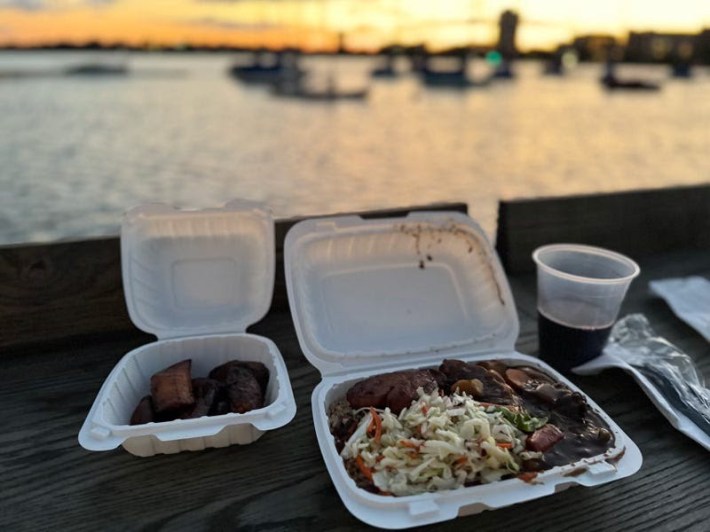
With the lake in the background, you can dine on braised oxtail ($22) with butter beans, carrot, potato, and country gravy. As well as Jamaican patties ($6), soft flakey dough filled with meat and spices (although the spices do seem to be dulled down to Minnesota standards to appease their customers). If you’ve still got room you might try the sweet fried plantains ($6) with a spiced vanilla glaze.
THE TASTING ROOM
Award winning sommelier Nico Giraud is co-owner and operator of this hidden gem along 31st Street just west of Hennepin. A small space tucked into a luxury condo building’s ground level, it boasts a beautiful interior finished with wood features behind a concrete bar. Giraud believes in Uptown, but says “the biggest enemy of Uptown right now is the construction.” He’s also frustrated with the vacancies, particularly the massive Seven Points building a few hundred feet from his door. “Until Seven Points redevelops, I don’t think anything else changes,” he says, adding that “anything you can do to get that space going, because what the neighborhood needs is life.”
Bartender Whitney Gale also shares Giraud’s frustrations, but speaks warmly about the neighborhood and the other restaurants nearby. “We get our cookies from Isles Bun, and usually Jeff [the owner] will walk over and hand deliver the order with a couple extra cookies for us to eat," she says. Sometimes if he has time she’ll pour him a glass and they’ll chat for a bit after he makes the delivery.
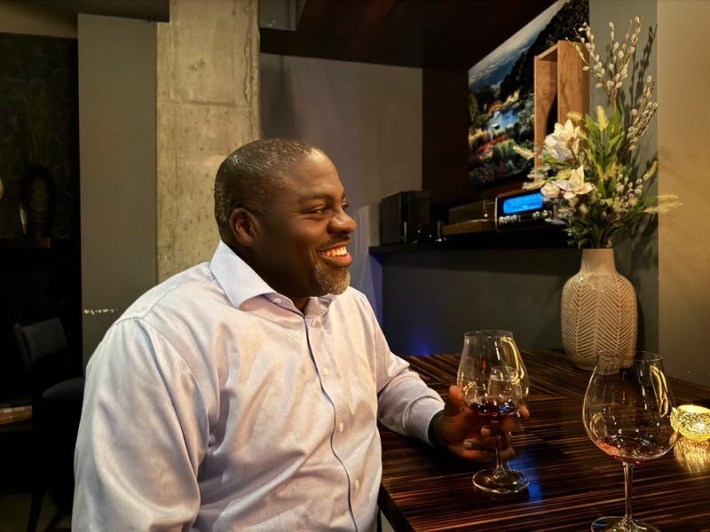
I recently visited The Tasting Room on a beautiful summer night with Gabe Afolayan, a friend of mine from college, who was student body president of Minnesota State University-Mankato, when I was on the student senate. One of my first visits to Uptown was during its heyday almost 20 years ago with Gabe, and I remember him singing “Last Call” from The College Dropout with the parking lot attendant at the lot next to McDonald’s.
Uptown was buzzing back then, and we had to push through crowds of people and puddles of spilled Mich Golden Light to get a drink at the bar which was aptly named Drink (that space has turned over a few times between now and then, but is currently called Uptown Ties… I think).
Today Gabe is a VP at a large local company and a part-time events DJ, and there are no crowds to push through to get a glass of wine from the bar.
We shared a foie gras torchon ($18) with sweet caramelized onion jam and fleur de sel on toasted brioche bread and a few glasses of sparkling rosé while we talked about the ghosts of Uptown’s past. “It’s almost more poetic that it’s faded away because the experiences we had in Uptown can never be had again,” Gabe says.
BLACK WALNUT BAKERY
Sarah Botcher opened Black Walnut Bakery at the corner of 32nd & Hennepin in November of 2019 just a few months before the global pandemic and well past the peak of Uptown as a destination retail hub. She’s spent the majority of her adult life living in Uptown and describes herself as “the village baker for Uptown.” The lower price point on her high end French inspired pastries makes them “an attainable little luxury that you can have every day in the way you can’t at a restaurant.”
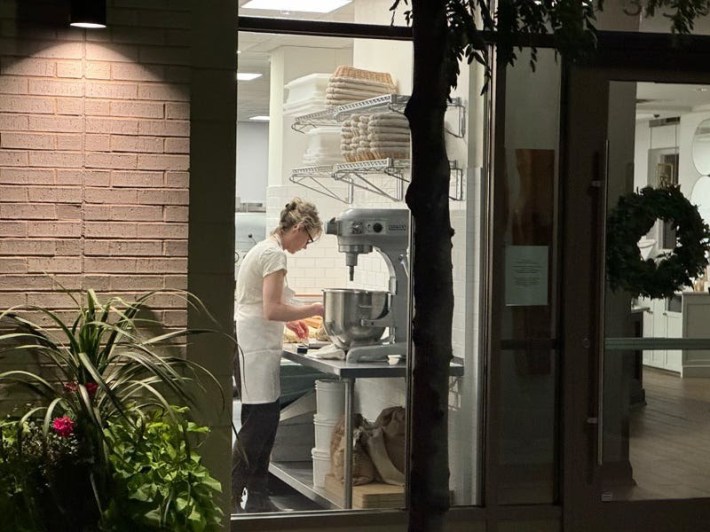
Even with a cup of coffee or tea (Black Walnut has some of the best tea options in the city) you can still easily spend less than $15 for a light breakfast at Black Walnut.
Neighbors are often lined up around the block for the croissants and other pastries Botcher makes with her team. She works overnights in Uptown, powered by coffee and a cookie to ensure pastries are fresh and ready in the morning. The delicate nature of making croissants means slight variations in humidity can totally change the consistency of the bread. While Black Walnut has a great staff, none of them have Botcher’s expertise. She can often be seen through the kitchen window of her bakery kneading dough at midnight.
“Black Walnut is one of the best bakeries in the country,” Jason DeRusha says. He and I met there a little while back to talk about Uptown and have egg sandwiches. The egg & cheese croissant bread sandwich ($12) is made from fluffy egg custard, gruyère, fine herbs, and chèvre spread on toasted croissant bread (made in house).
“Uptown always means more in terms of what it was than what it is or what it could be,” DeRusha says. “We’re nostalgic. We remember Figlio and Chino and when it wasn’t corporate. But it’s always been in flux.” As for what’s next, DeRusha says Uptown needs to “be reimagined as something different” than the destination retail hub that it’s been in the past.
Botcher also believes Uptown needs to go through an evolution to improve. “We all have to do our part, if everybody does that then Uptown can come back. Slowly but surely. One croissant at a time.”
Footnotes
- Editor's Note: Norton reached out to Northpond Partners for comment and did not receive a reply.Return to content at reference 1↩
- Writer's Note: For the purpose of this story we did not include Lyn-Lake or other areas nearby Uptown as part of Uptown and focused on the area unofficial Minneapolis historian David Brauer has outlined for Uptown. With the boundaries being Dupont to the east, the Chain of Lakes to the west, 33rd Street to the south, and just above 27th Street to the north.Return to content at reference 2↩







